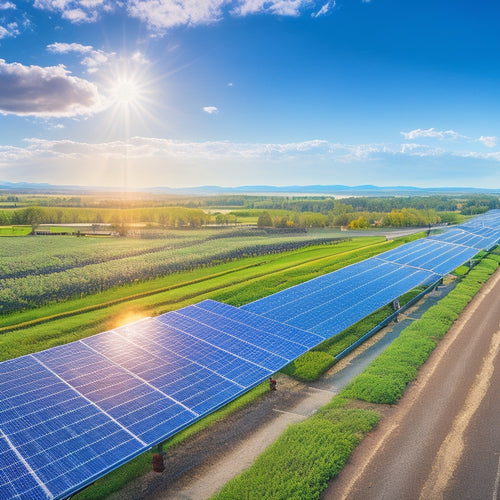
Solar Panels and Battery Storage
Share
By investing in solar panels and battery storage, you can greatly reduce your energy costs and increase your property's value. This technology utilizes renewable energy from the sun, contributing to energy independence and reduced reliance on the grid. With minimal maintenance requirements, you can enjoy sustained savings and reallocate resources to other priorities. As you investigate solar panels and battery storage, you'll want to assess your energy demands, optimize your energy use, and evaluate the importance of higher energy density and power efficiency - and that's just the beginning of revealing the full potential of this innovative technology.
The Essentials
- Solar panels and battery storage significantly reduce energy costs and enhance energy independence through renewable energy harnessing.
- Investment in solar technology increases property resale value by up to 17% and appeals to eco-conscious buyers.
- Efficient energy extraction techniques, such as Maximum Power Point Tracking, optimize energy harvesting and conversion in solar panels.
- Higher energy density in battery storage systems enables efficient energy storage and reduces reliance on fossil fuels.
- Aligning solar panel choice with specific energy needs ensures optimal performance and power efficiency.
Renewable Energy Saves Money
You'll find that investing in solar panels and battery storage can greatly reduce your energy costs. By utilizing renewable energy, you'll lower your utility bills and enjoy considerable long-term savings.
Additionally, with a home solar power battery, you can store excess energy generated during the day and use it at night or during power outages, providing a cleaner, more sustainable lifestyle.
With a well-designed system, you can expect to cut your energy expenditures by a significant margin, freeing up resources for other important priorities.
Energy Cost Reduction
Installing solar panels and battery storage systems can greatly reduce your energy costs by utilizing renewable energy from the sun.
By embracing a cleaner, more sustainable future, you can tackle three major concerns at once Energy Storage Systems and reduce your reliance on the grid.
You'll benefit from solar incentives, such as government rebates, and financing options that can help offset installation costs.
With energy independence, you'll have more control over your energy usage and expenses.
Plus, maintenance requirements are minimal, ensuring you can enjoy long-term energy savings.
Lower Utility Bills
As renewable energy generated from solar panels offsets your reliance on traditional power sources, your utility bills naturally decrease. This reduction in energy expenditure translates to significant savings over time, allowing you to allocate your resources more efficiently.
With government incentives and financing options available, the initial installation costs of solar panels and battery storage systems become more manageable. By utilizing solar energy, you're not only reducing your utility bills but also achieving energy independence and minimizing your environmental impact.
Additionally, a reliable solar panel and battery kit can provide a backup power source during frequent outages, guaranteeing that essential appliances and devices remain functional Off Grid Solar Systems. As your solar technology generates clean energy, you'll notice a decrease in your reliance on the grid connection.
With a battery storage system, you can store excess energy for later use, further reducing your energy costs. The maintenance requirements for solar panels are minimal, and their long lifespan guarantees a substantial return on investment.
Increases Property Value Fast
You'll likely see a significant increase in your property's resale value after installing solar panels and battery storage.
In fact, studies have shown that these eco-friendly additions can elevate your home's resale price by up to 17%.
With top residential solar roofing solutions like those offered by Tesla, Sunrun, and SunPower, homeowners can enjoy efficient and durable energy systems that not only save money on energy bills but also increase their property value sustainable energy solutions.
Boosts Resale Price
A solar panel system paired with battery storage can become a major selling point for your property, enhancing its resale price and appealing to environmentally conscious buyers.
As you consider investing in this technology, it's crucial to understand the impact on your property's value. With increased demand for eco-friendly features, market trends suggest that properties with solar panels and battery storage sell faster and at a higher price than those without.
You can expect a significant increase in resale price, with some studies indicating an increase of up to 17% or more.
This is because environmentally conscious buyers are willing to pay a premium for properties that reduce their carbon footprint. Additionally, the energy independence and cost savings provided by solar panels and battery storage make your property more attractive to potential buyers.
Enhances Home Appeal
Beyond the significant enhancement to resale price, a solar panel system with battery storage also increases your home's appeal, increasing its property value fast.
This improvement in appeal stems from the modern design and sleek aesthetic enhancements that come with integrating solar panels and battery storage into your home. The sleek, futuristic look of solar panels adds a touch of sophistication to your roof, while the compact design of battery storage systems seamlessly blends into your home's structure.
Additionally, the environmentally friendly aspect of solar energy appeals to the growing demographic of eco-conscious homeowners, further increasing your home's appeal. By investing in a solar panel system with battery storage, you're not only reducing your carbon footprint but also making a statement about your commitment to sustainability.
This unique combination of form and function makes your home stand out from the crowd, attracting potential buyers who value energy independence and modern design.
Maximum Power Point Tracking
You'll want to optimize energy harvesting by identifying the maximum power point (MPP) of your solar panels, as it varies with temperature and irradiance.
When implementing renewable energy storage, it's crucial to evaluate the efficiency of your solar panels.
Maximum power point tracking (MPPT) guarantees efficient power extraction by continuously monitoring and adjusting the operating voltage to match the MPP.
Optimizing Energy Harvesting
Its maximum power point (MPP) constantly shifts due to changes in temperature, irradiance, and other environmental factors, making it essential for solar panels to track this point to optimize energy harvesting.
To achieve this, you'll need a maximum power point tracking (MPPT) system. This technology guarantees your solar panels operate at their highest energy efficiency, regardless of the environmental conditions.
By optimizing energy harvesting, you'll maximize your solar technology's potential, reducing your reliance on the grid and minimizing your environmental impact.
When integrating MPPT into your system, you'll also extend your battery longevity and reduce installation costs.
With optimized energy harvesting, you'll have more control over your energy management, allowing for better performance monitoring and load balancing.
This means you can enjoy greater grid independence and freedom from reliance on external energy sources.
Efficient Power Extraction
The photovoltaic (PV) cells in your solar panel array convert sunlight into electrical energy, but their power output varies depending on environmental conditions.
To maximize energy conversion, you need a system that can track and adapt to these changes. This is where Maximum Power Point Tracking (MPPT) comes in - an essential component of efficient power extraction.
MPPT is an algorithm that continuously monitors the PV array's output and adjusts the operating point to guarantee maximum power efficiency.
It does this by identifying the ideal voltage and current combination that yields the highest power output. This optimization process occurs in real-time, allowing your system to respond to changes in temperature, irradiance, and other environmental factors.
Assess Your Energy Demands
You need to quantify your daily energy usage to determine the required solar panel and battery storage capacity.
To do this, you'll need to calculate your total daily energy consumption in watt-hours (Wh) and identify your peak hour demands, when your energy usage is highest.
Integrating renewable energy systems with advanced battery storage can help you generate clean energy and save on electricity bills.
Daily Energy Usage
Efficiency begins with a thorough understanding of your daily energy usage, a crucial step in determining the ideal solar panel and battery storage configuration for your unique needs.
To accurately assess your energy consumption, you'll need to examine your daily usage patterns. Start by tracking your energy usage over a week or month to identify your peak and off-peak hours. This will help you understand how much energy you consume during the day and when you need it most.
You'll want to evaluate factors such as your appliance usage, lighting, and heating or cooling systems.
Make a list of all your energy-intensive devices, including their wattage and usage times. This information will help you determine your overall energy consumption and identify areas where you can make adjustments to reduce your energy usage.
Peak Hour Demands
Peak hour demands, a critical aspect of your energy profile, reveal the times when your energy consumption surges. During these periods, your energy usage can strain the grid, compromising grid stability. To achieve energy independence, it is vital to understand and manage your peak hour demands.
| Time of Day | Energy Consumption | Appliances/Devices |
|---|---|---|
| 7:00 am | High | Coffee maker, lights, refrigerator |
| 12:00 pm | Medium | Computer, TV, air conditioning |
| 6:00 pm | High | Oven, dishwasher, washing machine |
| 9:00 pm | Medium | TV, lights, laptop |
| 11:00 pm | Low | Refrigerator, security system |
Higher Energy Density Matters
You're likely aware that higher energy density matters when it comes to battery storage.
What this means is that you're looking for the most power per unit of volume and weight.
When you prioritize power per unit, you can achieve more efficient energy storage and reduce the overall footprint of your system.
Power Per Unit
The quest for higher energy density in solar panels and battery storage systems is driven by the need to maximize power per unit area or volume. As you investigate the world of renewable energy, you'll realize that energy conversion and power efficiency are essential factors in achieving this goal. The more energy you can capture and store per unit, the more freedom you'll have from reliance on fossil fuels.
Here's a comparison of three popular solar panel models, highlighting their power per unit area:
| Model | Power per Unit Area (W/m²) | Efficiency (%) | Cost per Unit (USD/m²) |
|---|---|---|---|
| Panasonic HIT-240 | 240 | 21.8 | 250 |
| Tesla M10 | 210 | 20.5 | 220 |
| Trina TALLMAX M10 | 200 | 19.9 | 200 |
As you can see, the Panasonic HIT-240 boasts the highest power per unit area, making it an attractive option for those seeking maximum energy conversion. However, the Tesla M10 and Trina TALLMAX M10 offer competitive efficiencies and cost per unit, making them viable alternatives. When selecting a solar panel and battery storage system, consider your specific energy needs and prioritize the factors that matter most to you.
Frequently Asked Questions
Can I Install Solar Panels on My Old or Damaged Roof?
You'll need to assess your roof's condition before installing solar panels, as a damaged or old roof may require repairs or replacement, adding to installation costs, and potentially voiding warranties or compromising system performance.
How Long Does It Take to Charge a Solar Battery Fully?
You're wondering how long it takes to fully charge a battery. This depends on the charging efficiency, which varies by brand and model. Typically, it takes 2-5 hours to reach 80% capacity, but achieving 100% can add a few more hours, affecting the battery's lifespan.
Are Solar Panels and Battery Storage Systems Noisy?
You're wondering if your chosen energy solution is going to disturb your peace. Generally, you'll find that most systems operate quietly, with noise levels around 30-40 decibels, and a sound frequency that's barely perceptible, ensuring your freedom from noise pollution.
Can I Use Solar Power During a Grid Outage?
You can achieve grid independence during outages by designing a system that provides solar resilience, allowing you to capture and store energy when you need it most, ensuring your freedom from reliance on the grid.
Do Solar Panels Work Well in Shaded Areas or Cloudy Climates?
As you maneuver through the domain of renewable energy, you'll find that shading is a silent assassin, quietly slashing solar efficiency. Even partial shading can reduce output by up to 50%, making it vital to assess your site's shading impact before installation.
Final Thoughts
As you utilize the power of solar panels and battery storage, imagine yourself standing at the helm of a ship, steering through the turbulent seas of energy costs. With every kilowatt-hour generated, you're charting a course towards financial freedom. The prize? A wealth of savings, increased property value, and maximum power. The guide? Evaluating your energy demands and opting for higher energy density. Set sail for a brighter, more sustainable future, where the sun shines bright and your wallet smiles wide.
Related Posts
-

Diy Off Grid Solar
By embracing DIY off-grid solar, you can break free from grid dependence, slashing your energy bills by up to 90% and...
-

Applications of Photovoltaic Systems
Photovoltaic systems are versatile, converting sunlight into electricity for various applications. You can use them i...
-

Smart Grid Technology Implementation Challenges
You'll encounter several challenges when implementing smart grid technology, particularly in cost management, scalabi...


